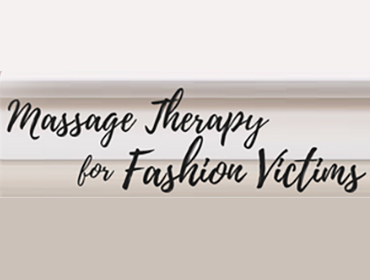Don’t Suffer for the Sake of Fashion
“Beauty is pain”, right? Many of us are familiar enough with the feeling of hobbling around after a night in high heels or the dull ache that comes from carrying around a heavy yet stylish purse, but there’s no reason to suffer in silence. Registered Massage Therapists (RMTs) can help treat your fashion pains.
Fashion Victims
 Some people wear high heels every day, and others only on special occasions. But no matter how often you wear them, high heels can alter the alignment of the feet, legs and back, and can have long-term effects on posture and health [1].
Some people wear high heels every day, and others only on special occasions. But no matter how often you wear them, high heels can alter the alignment of the feet, legs and back, and can have long-term effects on posture and health [1].
High heels can lead to increased pressure and friction under the heel, the ball of the foot, and the big toe [2]. This increased pressure has been thought to lead to bunions, neuromas (thickened nerves), restricted ankle movements, shortened calf muscles and a broader and stiffer Achilles tendon [1,3]. Prolonged use of stiletto heels has also been found to increase activity in cervical paraspinal muscles (the small muscles at the back of the neck), which can lead to paraspinal muscle fatigue [4,5]. High-heeled shoes can also tip the body forwards and interfere with normal coordination of muscles that stabilize the lower spine, which can lead to repetitive strain injuries [1,6].
Heavy purses have their own problems, depressing the shoulder on whichever side you’re carrying it, causing the muscles in that shoulder to work harder. This can lead to overuse and fatigue, also increasing the chances for shoulder injury [7]. Specifically, when a bag or a purse is worn consistently on one shoulder, an increased muscle activity of the trapezius muscle is observed on the shoulder that the bag is worn on. The added weight on one half of the back can also cause strain on the spine and can lead to back pain [8].
What Can You Do About It?
 Selecting the right purse and making sure it’s not too heavy goes a long way towards preventing pain before it happens. Experts recommend that your bag weigh no more than 10% of your body weight – preferably less if you’re putting it over one shoulder like a purse. It’s also recommended that you opt for a wider strap – distributing the weight over a wider area. You can also try switching shoulders periodically, and ensuring that your purse straps aren’t too short or too long.
Selecting the right purse and making sure it’s not too heavy goes a long way towards preventing pain before it happens. Experts recommend that your bag weigh no more than 10% of your body weight – preferably less if you’re putting it over one shoulder like a purse. It’s also recommended that you opt for a wider strap – distributing the weight over a wider area. You can also try switching shoulders periodically, and ensuring that your purse straps aren’t too short or too long.
Recommending that no one ever wear high heels is likely unrealistic advice, but there are still things you can do to make sure your time in heels isn’t a painful experience. If possible, you can limit the amount of time during the day that you wear high heels, taking a pair of more comfortable shoes to change into. You can also choose a shoe with a wider heel, which reduces the load on the front of your foot, and choose a shoe with a moderate heel height, no more than five centimeters. It might also be helpful to do calf strengthening exercises to help maintain ankle flexibility.
Massage Therapy Can Help
 Massage therapy can effectively treat the pain and discomfort that may come from these fashion choices. Knee problems can be a concern when wearing high-heeled shoes due to increased stress on the knees, and massage therapy can safely and effectively reduce pain and improve function in the knee [9,10].
Massage therapy can effectively treat the pain and discomfort that may come from these fashion choices. Knee problems can be a concern when wearing high-heeled shoes due to increased stress on the knees, and massage therapy can safely and effectively reduce pain and improve function in the knee [9,10].
A survey of young women found that 58% of young women who wore high heels regularly experienced low back pain, and low back pain is a common problem for regular wearers of high heels of all ages [11]. Massage therapy can be beneficial in treating chronic low back pain. In addition to decreased pain, massage therapy can lead to improved mood, improved sleep, and increased range of motion in patients with chronic back pain [12,13].
When walking in heels regularly, the upwards and outwards movement of the foot at the ankle joint becomes restricted, lower leg muscles have to work harder to balance the unstable ankle, and the risk of ankle sprains increases [14]. Massage therapy has been found to increase range of motion and decrease pain in individuals with orthopedic ankle impairments [15,16].
Massage therapy can also help with the shoulder issues that come from carrying around a heavy purse all day. Massage therapy is an effective treatment for patients with posterior shoulder tightness, improving range of motion and decreasing muscle tightness [17]. When hands-on manual therapy is combined with active stretching exercises, it can decrease upper back and neck pain caused by repetitive strain and overuse [18].
References
[1] Robinson, C. (2014). Health Check: How high heels harm and how to make it better. The Conversation. Retrieved September 21, 2017 [link]
[2] Stomp, W., Krabben, A., van der Helm-van Mil, A., Reijnierse, M. (2014). Effects of wearing high heels on the forefoot: an MRI evaluation. Scand J Rheumatol, 43(1):80-81. [link]
[3] Csapo, R., Maganaris, C.N., Seynnes, O.R., Narici, M.V. (2010). On muscle, tendon and high heels. J Exp Biol, 213(15):2582-2588. [link]
[4] Mika A, Oleksy Ł, Mikołajczyk E, et al. (2011). Changes of bioelectrical activity in cervical paraspinal muscle during gait in low and high heel shoes. Acta Bioeng Biomech, 13:27–33. [link]
[5] Park, K., Kim, Y., Chung, Y., Hwang, S. (2016). Effects of the height of shoe heels on muscle activation of cervical and lumbar spine in healthy women. J Phys Ther Sci, 28(3):956-959. [link]
[6] Silva, A.M., de Sigueira, G.R., da Silva, G.A. (2013). Implications of high-heeled shoes on body posture of adolescents. Rev Paul Pediatr, 31(2):265-271. [link]
[7] Zultowski, I., Aruin, A. (2008). Carrying loads and postural sway in standing: the effect of load placement and magnitude. Work, 30(4):359-368. [link]
[8] Cho, S.H., Lee, J.H., Kim, C.Y. (2013). The changes of electromyography in the upper trapezius and supraspinatus of women college students according to the method of bag-carrying and weight. J Phys Ther Sci, 25(9):1129-1131. [link]
[9] Perlman, A.I., Sabina, A., Williams, A., Njike, V.Y., Katz, D.L.. (2006). Massage therapy for osteoarthritis of the knee: a randomized controlled trial. Arch Intern Med, 166(22):2533-2538. [link]
[10] Titchenal, M.R., Asay, J.L., Favre, J., Andriacchi, T.P., Chu, C.R. (2015). Effects of high heel wear and increased weight on the knee during walking. J Orthop Res, 33(3):405-411. [link]
[11] Lee, C.M., Jeong, E.H., Freivalds, A. (2001). Biomechanical effects of wearing high-heeled shoes. Int J Ind Ergon, 28(6):31-326. [link]
[12] Cherkin, D.C., Sherman, K.J., Kahn, J., Wellman, R., Cook, A.J., et al. (2011). A comparison of the effects of 2 types of massage and usual care on chronic low back pain: a randomized, controlled trial. Ann Intern Med, 155(1):1-9. [link]
[13] Hernandez-Reif, M., Field, T., Krasnegor, J., Theakston, H. (2001). Lower back pain is reduced and range of motion increased after massage therapy. Int J Neurosci, 106(3-4):131-145. [link]
[14] Moore, J.X., Lambert, B., Jenkins, G.P., McGwin, G. (2015). Epidemiology of high-heel shoe injuries in U.S. women: 2002 to 2012. J Foot Ankle Surg, 54(4):615-619. [link]
[15] Southerst, D., Yu, H., Randhawa, K., Côté, P., D’Angelo, K., et al. (2015). The effectiveness of manual therapy for the management of musculoskeletal disorders of the upper and lower extremities: a systematic review by the Ontario Protocol for Traffic Injury Management (OPTIMa) Collaboration. Chiropr Man Therap, 23:30 [link]
[16] Cleland, J.A., Mintken, P.E., McDevitt, A., Bieniek, M.L., Carpenter, K.J., Kulp, K., Whitman, J.M. (2013). Manual physical therapy and exercise versus supervised home exercise in the management of patients with inversion ankle sprain: a multicenter randomized clinical trial. J Orthop Sports Phys Ther, 43(7):443-55 [link]
[17] Yang, J.L., Chen, S.Y., Hsieh, C.L., Lin, J.J. (2012). Effects and predictors of shoulder muscle massage for patients with posterior shoulder tightness. BMC Musculoskelet Disord, 13:46. [link]
[18] Pesco, M.S., Chosa, E., Tajima, N. (2006). Comparative study of hands-on therapy with active exercises vs education with active exercises for the management of upper back pain. J Manipulative Physiol Ther, 29(3):228-235. [link]


Leave a Comment